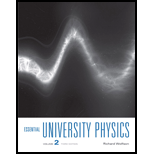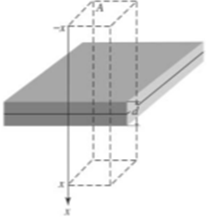
Concept explainers
A charged slab extends infinitely in two dimensions and has thickness d in the third dimension, as shown in Fig. 21.36. The slab carries a uniform volume charge density ρ. Find expressions for the electric field (a) inside and (b) outside the slab, as functions of the distance x from the center plane. (Although the infinite slab is impossible, your answer is a good approximation to the field of a finite slab whose width is much greater than its thickness.)

59. INTERPRET The infinitely large slab has plane symmetry, and we can apply Gauss’s law to compute the electric field.
DEVELOP When we take the slab to be infinitely large, the electric field is everywhere normal to the slab's surface and symmetrical about Die center plane we follow the approach outlined in example 21.6 to compute the electric field. As the Gaussian surface, we choose a box that has area A on its top and bottom and that extends a distance x both up and down from the center of the slab. See figure below.

EVALUATE (a) For points inside the slab |x| ≤ d/2, the charge enclosed by our Gaussian box is
qenclosed = ρVenclosed = ρA(2x)
Thus, Gauss’s law gives
The direction of
(b) For points outside the slab |x| > d/2. the enclosed charge is
qenclosed = ρVenclosed = ρA(d)
Applying Gauss’s law again gives
Learn your wayIncludes step-by-step video

Chapter 21 Solutions
Essential University Physics: Volume 2 (3rd Edition)
Additional Science Textbook Solutions
Introductory Chemistry (6th Edition)
Cosmic Perspective Fundamentals
Human Anatomy & Physiology (2nd Edition)
Microbiology: An Introduction
Biology: Life on Earth (11th Edition)
Applications and Investigations in Earth Science (9th Edition)
- No chatgpt pls will upvotearrow_forwardUse the following information to answer the next question. Two mirrors meet an angle, a, of 105°. A ray of light is incident upon mirror A at an angle, i, of 42°. The ray of light reflects off mirror B and then enters water, as shown below: Incident ray at A Note: This diagram is not to scale. a Air (n = 1.00) Water (n = 1.34) 1) Determine the angle of refraction of the ray of light in the water. Barrow_forwardHi can u please solvearrow_forward
- 6. Bending a lens in OpticStudio or OSLO. In either package, create a BK7 singlet lens of 10 mm semi-diameter and with 10 mm thickness. Set the wavelength to the (default) 0.55 microns and a single on-axis field point at infinite object distance. Set the image distance to 200 mm. Make the first surface the stop insure that the lens is fully filled (that is, that the entrance beam has a radius of 10 mm). Use the lens-maker's equation to calculate initial glass curvatures assuming you want a symmetric, bi-convex lens with an effective focal length of 200 mm. Get this working and examine the RMS spot size using the "Text" tab of the Spot Diagram analysis tab (OpticStudio) or the Spd command of the text widnow (OSLO). You should find the lens is far from diffraction limited, with a spot size of more than 100 microns. Now let's optimize this lens. In OpticStudio, create a default merit function optimizing on spot size.Then insert one extra line at the top of the merit function. Assign the…arrow_forwardNo chatgpt pls will upvote Already got wrong chatgpt answer .arrow_forwardUse the following information to answer the next question. Two mirrors meet an angle, a, of 105°. A ray of light is incident upon mirror A at an angle, i, of 42°. The ray of light reflects off mirror B and then enters water, as shown below: A Incident ray at A Note: This diagram is not to scale. Air (n = 1.00) Water (n = 1.34) Barrow_forward
- Use the following information to answer the next question. Two mirrors meet an angle, a, of 105°. A ray of light is incident upon mirror A at an angle, i, of 42°. The ray of light reflects off mirror B and then enters water, as shown below: A Incident ray at A Note: This diagram is not to scale. Air (n = 1.00) Water (n = 1.34) Barrow_forwardGood explanation it sure experts solve it.arrow_forwardNo chatgpt pls will upvote Asaparrow_forward
- A satellite has a mass of 100kg and is located at 2.00 x 10^6 m above the surface of the earth. a) What is the potential energy associated with the satellite at this loction? b) What is the magnitude of the gravitational force on the satellite?arrow_forwardNo chatgpt pls will upvotearrow_forwardCorrect answer No chatgpt pls will upvotearrow_forward
 Principles of Physics: A Calculus-Based TextPhysicsISBN:9781133104261Author:Raymond A. Serway, John W. JewettPublisher:Cengage Learning
Principles of Physics: A Calculus-Based TextPhysicsISBN:9781133104261Author:Raymond A. Serway, John W. JewettPublisher:Cengage Learning Physics for Scientists and Engineers: Foundations...PhysicsISBN:9781133939146Author:Katz, Debora M.Publisher:Cengage Learning
Physics for Scientists and Engineers: Foundations...PhysicsISBN:9781133939146Author:Katz, Debora M.Publisher:Cengage Learning Physics for Scientists and EngineersPhysicsISBN:9781337553278Author:Raymond A. Serway, John W. JewettPublisher:Cengage Learning
Physics for Scientists and EngineersPhysicsISBN:9781337553278Author:Raymond A. Serway, John W. JewettPublisher:Cengage Learning Physics for Scientists and Engineers with Modern ...PhysicsISBN:9781337553292Author:Raymond A. Serway, John W. JewettPublisher:Cengage Learning
Physics for Scientists and Engineers with Modern ...PhysicsISBN:9781337553292Author:Raymond A. Serway, John W. JewettPublisher:Cengage Learning College PhysicsPhysicsISBN:9781305952300Author:Raymond A. Serway, Chris VuillePublisher:Cengage Learning
College PhysicsPhysicsISBN:9781305952300Author:Raymond A. Serway, Chris VuillePublisher:Cengage Learning





